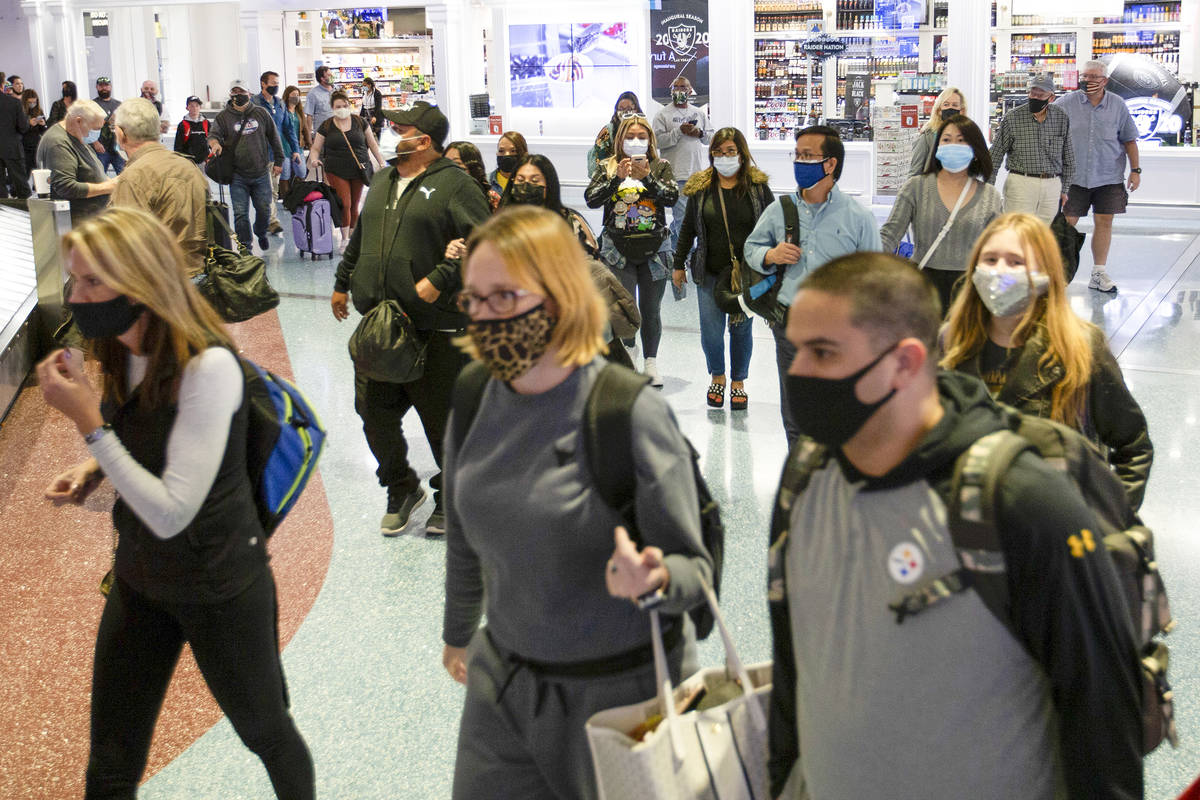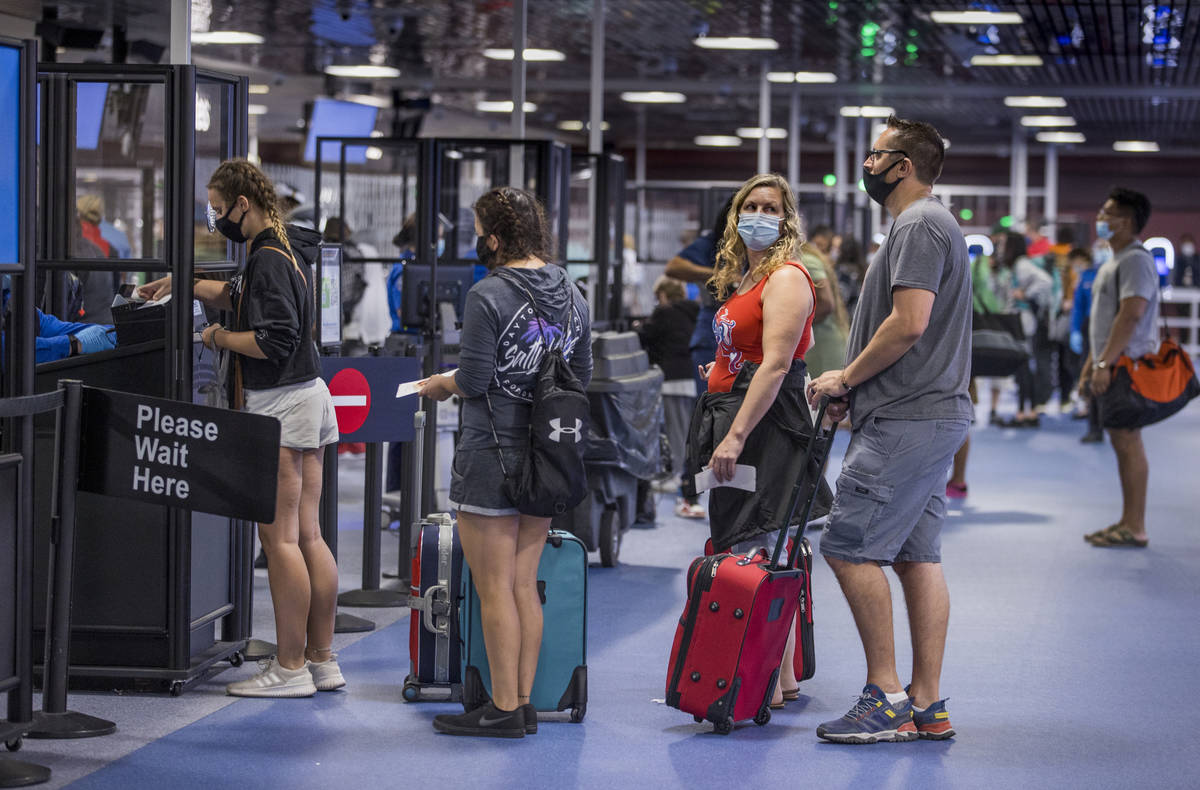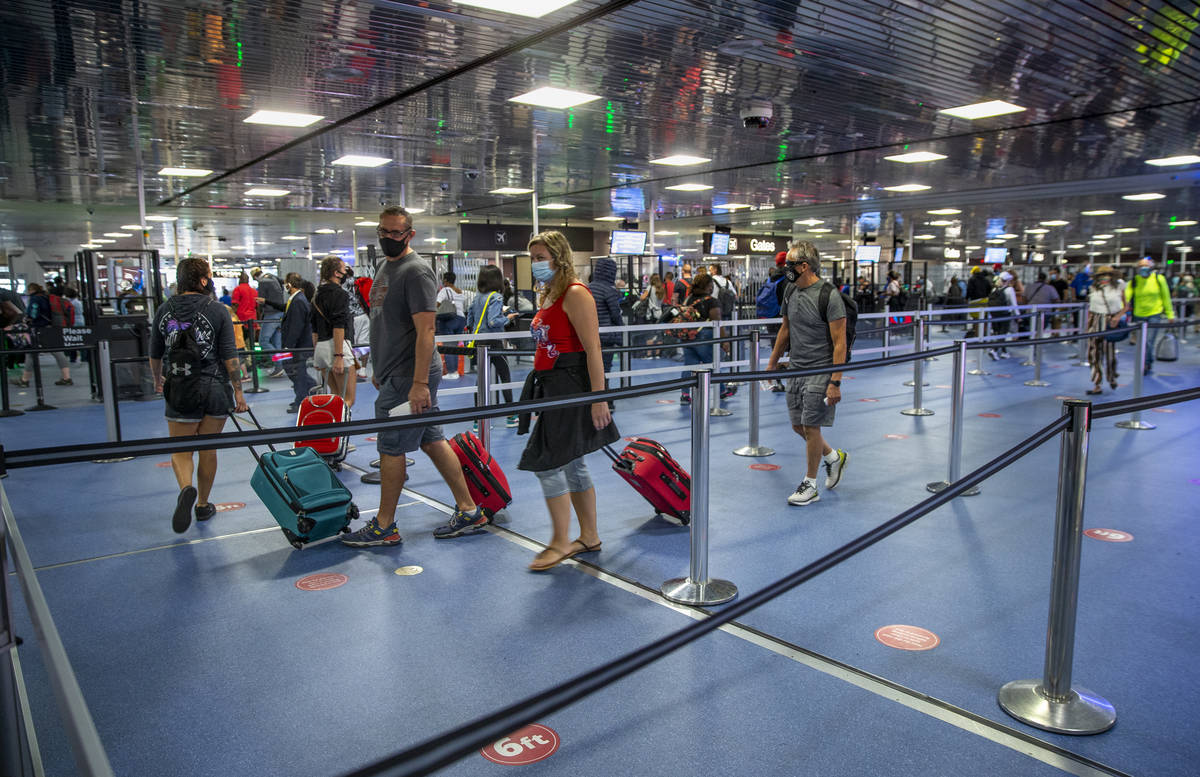Spike in COVID-19 cases at McCarran has TSA employees worried
A continuing spike in COVID-19 cases among Transportation Security Administration employees at McCarran International Airport has the local workforce concerned.
As of Wednesday, the TSA reported 101 confirmed cases of coronavirus among TSA employees at McCarran since the pandemic began, marking a 55 percent increase since Nov. 19 when 65 cases were noted.
The percentage increase locally is almost double the amount seen at TSA checkpoints at airports nationwide during that time, as between Nov. 19 and Wednesday there was a collective 28 percent increase in cases reported.
“Most definitely the officers are worried,” Becky Esquivel, American Federation of Government Employees Local 1250 vice president, who represents TSA employees, told the Review-Journal. “There is a lot of concern.”
Nationwide, 3,823 TSA employees tested positive for COVID-19 as of Tuesday, with 760 of those marked as active cases. There is no data available to indicate how many of the McCarran cases are active, but TSA data notes the last positive case occurred on Monday.
As of Wednesday, nine of the more than 400 federalized airports have reported at least 100 positive cases of the virus, with Miami International Airport seeing the most cases with 194, TSA data revealed.
Ten TSA employees have died from COVID-19 complications, with one new death reported by the agency since Nov. 19.
Numbers spiking
During a 58-day stretch between Aug. 25 and Oct. 22, the TSA reported 10 new cases of coronavirus among TSA employees at McCarran.
In the following 48-day stretch, from Oct. 22 to Wednesday, TSA data shows a significantly larger increase in total cases at McCarran: 60 new positive cases reported for a 66 percent spike.
Nationally between Aug. 25 and Oct. 22, the TSA reported 472 new cases of employees testing positive for the virus, while between Oct. 22 and Tuesday, 1,619 new positive tests were reported, accounting for a 73 percent increase.
With those who test positive, those found to have had contact with an infected employee also are placed into quarantine, as recommended by the Centers for Disease Control and Prevention.
The TSA does not provide the number of quarantined employees or the number of TSA agents at each airport because of security concerns, according to TSA spokeswoman Lorie Dankers.
Esquivel said the recent spike is creating some staffing issues.
“We’re understaffed as we have so many officers who are out sick,” she said. “Not only the officers that have tested positive, but any exposure to any co-worker means that those co-workers are sent home as well.”
Although she’s not told specifics of employees’ illness due to privacy laws, Esquivel knows some infected employees have been out longer than the two week quarantine period because the virus affected them more.
“We have had officers that have been hospitalized,” Esquivel said. “I know of one that hasn’t come back to work.”
Any area an infected employee was found to have been in during contact tracing efforts are deep cleaned.
Travel has been steadily increasing at airports across the nation, especially around the Thanksgiving holiday, when the TSA screened the most passengers since the pandemic’s effects began to be felt in mid-March. Despite the recent increase, passenger levels are still down significantly across the nation.
Through Monday and Tuesday, the TSA screened 1.2 million passengers, down from the 3.1 million passengers screened during the same two-day stretch last year.
Increased safety measures
The rise in cases is occurring even after the agency increased health and safety protocols at McCarran and other airports.
Those measures include installing 72 acrylic protective barriers at McCarran in August. The effort was part of 1,230 barriers installed at airports nationwide in areas where TSA employees and travelers engage with one another.
Also, the TSA installed technology in the security checkpoint to reduce physical contact, Dankers said. At McCarran, the Credential Authentication Technology units in use allow travelers to insert their photo ID, reducing the need to hand it to a TSA officer.
All TSA officers are required to wear surgical or N95 masks and nitrile gloves. Those who work in close contact with travelers also are required to wear eye protection, Dankers said.
“Whether that’s enough protection, I don’t know. I’m not a doctor” Esquivel said. “I do know from what I’m hearing from professionals is this virus lives on surfaces. We touch people, we touch their property, and I don’t know, am I bringing it home on my clothing? I don’t know. … I’m worried. I am concerned.”
Having just returned to work herself after being out two weeks because of a potential exposure to an infected employee, Esquivel said that even with all the safety measures some passengers still present issues to officers.
“We cannot insist that they wear a mask, that’s a concern,” Esquivel said. “Most people do have a mask, but some people don’t want to cover their face correctly. They’re wearing the mask barely covering their lips or they pull it down to talk to us. … Most of them are considerate, but some passengers aren’t. … I just have to hope the protection that I am using is good enough.”
The TSA also has social distancing measures in place to help limit crowding, reducing the time travelers and TSA employees are in close proximity to each other.
“For social distancing purposes and because passenger volumes remain below pre-pandemic levels, TSA regularly staffs additional lanes in security checkpoints when possible to allow travelers and our employees additional space to spread out,” Dankers said. “If additional lanes are not available, we will alternate lane availability to allow travelers and our employees extra space to spread out.”
Contact Mick Akers at makers@reviewjournal.com or 702-387-2920. Follow @mickakers on Twitter.



















































